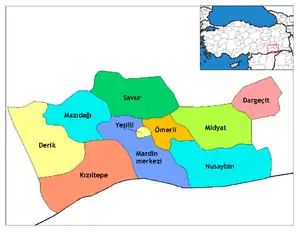Ömerli, Mardin
Ömerli (Syriac: ܡܥܨܪܬܗ, romanized: Maʿsarteh,[3][nb 1] Kurdish: Mahsertê,[6] Arabic: معسرتي)[3] is a town and district in Mardin Province in southeastern Turkey. It is located in the historical region of Tur Abdin.
Ömerli | |
|---|---|
 Ömerli | |
| Coordinates: 37°24′09″N 40°57′22″E | |
| Country | Turkey |
| Province | Mardin |
| District | Ömerli |
| Government | |
| • Mayor | Süleyman Tekin (BDP) |
| • Kaymakam | Tekin Erdemir |
| Area | |
| • District | 400.48 km2 (154.63 sq mi) |
| Elevation | 1,100 m (3,600 ft) |
| Population (2012)[2] | |
| • Urban | 6,245 |
| • District | 14,629 |
| • District density | 37/km2 (95/sq mi) |
| Post code | 47570 |
| Website | www.omerli.bel.tr |
In the town, there was a church of Saint George (Turkish: Mor Cercis Kilisesi).[7] The church of Saint George was later converted into a mosque.[5]
Etymology
The Syriac name of the town is derived from "ma'ṣartā" ("wine-press" in Syriac).[4]
History
Maʿsarteh is identified as the town of Madaranzu in Bit-Zamani,[4] which was conquered by Ashurnasirpal II, King of Assyria, in 879 BC.[8] It is later mentioned by Theophylact Simocatta and George of Cyprus as Matzaron (Greek: Ματζάρων, Latin: Mazarorum).[4] The town was likely captured by a Sasanian army in 573 at the time of the siege of Dara,[9] during the Roman-Sasanian War of 572-591, but was retaken and the fort was restored by the Roman commanders Theodore and Andrew in 587.[10]
Maʿsarteh was part of the Syriac Orthodox diocese of the Monastery of Saint Abai (Classical Syriac: ܕܝܪܐ ܕܡܪܝ ܐܒܝ, romanized: Dayro d-Mor Abay)[11] until the death of its last bishop Isḥoq Ṣaliba in 1730, upon which the diocese was subsumed into the diocese of Mardin.[12] German orientalist Eduard Sachau visited the town in 1880.[5] Until the Assyrian genocide, the town was exclusively populated by Assyrians of the Syriac Orthodox Church.[13] Survivors of the genocide fled to the Monastery of Saint Ananias.[14]
After the Assyrian genocide, Assyrians from Maʿsarteh emigrated to Bethlehem and Jerusalem.[15] In 1925, the town became the seat of a bucak (subdistrict) of Savur, and was elevated to district in 1953.[7] In 1960, Maʿsarteh was officially renamed Ömerli.[16] By 1989, all Assyrian families had fled the town,[17] however, some later returned and, as of 2013, three Assyrian families inhabit the town.[18] The district is also populated by Mhallami.[19]
Notable people
- Ḥanna Salmān (1914-1981), Assyrian author[20]
References
Notes
Citations
- "Area of regions (including lakes), km²". Regional Statistics Database. Turkish Statistical Institute. 2002. Retrieved 2013-03-05.
- "Population of province/district centers and towns/villages by districts - 2012". Address Based Population Registration System (ABPRS) Database. Turkish Statistical Institute. Retrieved 2013-02-27.
- Carlson, Thomas A. (9 December 2016). "Maʿsarteh". The Syriac Gazetteer. Retrieved 15 May 2020.
- Lipiński (2000), pp. 141-142.
- Wannes (2006), p. 25.
- Avcıkıran (2009), p. 55.
- Ömerli. Mardin Valiliği (in Turkish).
- Palmer (1990), p. 1.
- Whitby & Whitby (1986), p. 69.
- Shahîd (1995), p. 552.
- Carlson, Thomas A. (6 February 2014). "Dayro d-Mor Abay". The Syriac Gazetteer. Retrieved 15 May 2020.
- Kiraz (2011b).
- Jongerden & Verheij (2012), p. 320.
- Brock (2017), p. 150.
- Calder (2015), p. 206.
- Aydin (2018), p. 104.
- Atto (2011), p. 174.
- Courtois (2013), p. 145.
- Ghadban (2008), p. 86.
- Kiraz (2011a).
Biography
- Atto, Naures (2011). Hostages in the Homeland, Orphans in the Diaspora: Identity Discourses Among the Assyrian/Syriac Elites in the European Diaspora (PDF). Leiden University Press. Retrieved 27 December 2019.
- Avcıkıran, Adem (2009). Kürtçe Anamnez Anamneza bi Kurmancî (PDF) (in Turkish and Kurdish). Retrieved 17 December 2019.
- Aydin, Julius Hanna (2018). Die Vita des Reklusen Mor Jakob von Salah (in German). LIT Verlag Münster.
- Brock, Sebastian (2017). "A Historical Note of October 1915 Written in Dayro D-Zafaran (Deyrulzafaran)". In David Gaunt; Naures Atto; Soner O. Barthoma (eds.). Let Them Not Return: Sayfo – The Genocide against the Assyrian, Syriac and Chaldean Christians in the Ottoman Empire. pp. 148–157.
- Calder, Mark Daniel (2015). "We are the mother of the Arabs" : articulating Syriac Christian selfhood in Bethlehem. Retrieved 30 December 2019.
- Courtois, Sébastien de (2013). "Tur Abdin : Réflexions sur l'état présent descommunautés syriaques du Sud-Est de la Turquie,mémoire, exils, retours". Cahier du Gremmamo (in French). 21: 113–150.
- Ghadban, Ralph (2008). Die Libanon-Flüchtlinge in Berlin (PDF) (in German). Retrieved 30 December 2019.
- Jongerden, Joost; Verheij, Jelle (2012). Social Relations in Ottoman Diyarbekir, 1870-1915. Brill.
- Kiraz, George A. (2011a). "Salmān, Ḥanna". Gorgias Encyclopedic Dictionary of the Syriac Heritage: Electronic Edition. Gorgias Press.
- Kiraz, George A. (2011b). "Isḥoq Ṣaliba". Gorgias Encyclopedic Dictionary of the Syriac Heritage: Electronic Edition. Gorgias Press.
- Lipiński, Edward (2000). The Aramaeans: Their Ancient History, Culture, Religion. Peeters Publishers.
- Palmer, Andrew (1990). Monk and Mason on the Tigris Frontier: The Early History of Tur Abdin. Cambridge University Press.
- Shahîd, Irfan (1995). Byzantium and the Arabs in the Sixth Century, vol. 1, part 1: Political and Military History. Dumbarton Oaks.
- Wannes, Sűleyman (2006). Syrisk-ortodoxa kyrkan, en överblick över Institutioner, stiftelser och medlemmar, samt civila och profana organisationer i världen (PDF) (in Swedish). Retrieved 30 December 2019.
- Whitby, Michael; Whitby, Mary (1986). The History of Theophylact Simocatta. Claredon Press.
